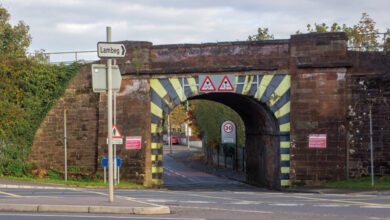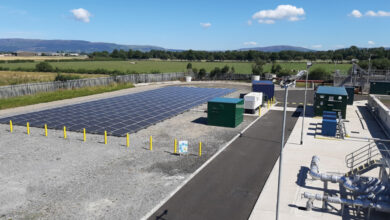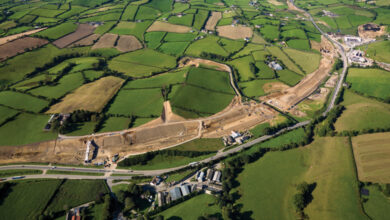Planning for regional growth

Northern Ireland’s Chief Planner Fiona McCandless discusses the implementation of the Regional Development Strategy (RDS) and the benefits of cross-border collaboration in a spatial planning context.
Speaking to an audience in Dublin, Chief Planner Fiona McCandless explains that the development of the National Planning Framework has provided a further opportunity to align spatial planning policies in both jurisdictions. This collaborative working and improved understanding has led to a strong commonality of themes and approaches in both spatial strategies.
Outlining the RDS, a long-term spatial plan to 2035, McCandless says: “The strategy is not limited to land use but recognises that our spatial development policies have far-reaching implications for society, our economy and our environment. It impacts on our lives, on the lives of future generations and plays a crucial role in our quality of life, our wellbeing and our sense of place.”
Particularly relevant for Northern Ireland, the RDS is aimed at achieving long-term sustainable development and social cohesion.
The strategy not only recognises the key role Belfast has in generating regional prosperity and the importance of the Belfast/Dublin corridor but also pinpoints Derry/ Londonderry as a focus for economic growth in the North West, and the importance of key settlements as centres for growth.
Its statutory basis means that it is complementary to other key government policies such as the Programme for Government, the Investment Strategy and the Sustainability Strategy.
McCandless adds: “It has the potential to influence the future distribution of development throughout the North and it takes account of the key factors such as population growth, movement, demographic change, our transportation needs, economic change and the spatial implications of divisions within our society.
“It also addresses climate change, it encourages the development of an integrated sustainable transport network and future cooperation for border areas and cross-border infrastructure.” However, McCandless states that the strategy does not contain operational planning policy or guidance.
Background
The Regional Development Strategy, the most recent version of which was published in 2012, contains four key elements. As well as being a spatial framework, dividing Northern Ireland into five components based on function and geography, the framework is also underpinned by guidance on two levels. Firstly, regional guidance and secondly, specific guidance for each element of the spatial framework.
A third key element centres on regionally significant economic infrastructure and acknowledges its importance in delivering the region’s economic and social aspirations, setting out strategic improvements in transport, telecoms, renewable energy and waste infrastructure. The fourth key element is an implementation section.
Key features
Outlining the importance of the Belfast metropolitan area, as well as the North West region, encompassing Derry/ Londonderry, Strabane, Limavady and across the border into Donegal, McCandless also points to hub and cluster identification in the strategy.
She says: “There are a number of hubs and clusters, with the main hubs being those identified as having the greatest potential for growth and which provide a range of services. We’ve clustered our cities and towns and promoted a framework to encourage cooperation and sharing, rather than duplication of services. We also have identified a number of key gateways and corridors.
“These are the strategically important transport interchanges, which have significant economic development opportunities, freight distribution activities, additional employment generation and have the potential to open up opportunities across the North. There is also a particular focus on rural areas.
“The guiding principle of the spatial framework is to put people at the centre and to do this we require a greater understanding of how different areas are influenced by the range of services surrounding them, the functions they provide and where they are located.”
The creation of a two-tier planning system in Northern Ireland in 2015 has allowed for greater effectiveness of the RDS. As well as a key point of direction for the creation of all 11 local councils’ development plans, and although not containing operational policy and guidance, it is material to all decisions and appeals. “The RDS provides an overall context and direction for the preparation of policies and ensures alignment between regional and local plans,” explains McCandless.
“Spatial development policies have far-reaching implications for society, our economy and our environment. It impacts on our lives, on the lives of future generations and plays a crucial role in our quality of life, our wellbeing and our sense of place.”
Implementation
McCandless admits that implementation of the strategy has not been entirely smooth.
“I don’t think it is a result of any failure of the strategy but really it was down to issues around implementation. We are considering our approach and looking at improved ways to provide a more robust assessment of delivery.
“The existing RDS provides a context for cooperation and spatial planning on a cross-border basis. Officials in the Department for Infrastructure are working closely with colleagues in the Department of Housing Planning Community and Local Government to make sure that, where possible, we align both strategies. This approach was established in the framework for co-operation, which both governments jointly published in relation to spatial planning.” McCandless also highlighted that the former Infrastructure Minister, Chris Hazzard MLA recognised that the optimal performance of both administrations was influenced by how cohesive they are in terms of connectivity and strategic development and that a collaborative approach to infrastructure planning and development would bring benefits to both jurisdictions and provide a strong foundation for future economic growth.”
Challenges
Brexit poses a further challenge to collaboration across both jurisdictions admits McCandless. It is therefore important that we work together to ensure that we minimise possible impacts and make the most of potential opportunities as they arise. However, rather than focus on negatives, McCandless believes that planning in Northern Ireland should look at opportunities to improve.
She says: “We now have an extensive programme of local development plans in preparation. These will provide a clear vision for future growth and give confidence to our communities. All councils have bought into this, but it gives us an enhanced need to ensure that we have a centrally-based strategy that gives effect to central priorities. We need to ensure that infrastructure delivery isn’t fragmented and that investment decisions are made in that broader context.
Central government has also undergone a transformation in the number and shape of the departments and the planning function, which now sits within the Department for Infrastructure, has become much more co-ordinated and integrated with transportation planning, flood risk management and with water infrastructure. Through this co-ordinated approach we will be able to influence longer-term investment decisions in a much more coherent way.
“We view the National Planning Framework as an opportunity for regional planning in the North to develop further work on how we plan at a regional level. Our previous Minister gave us direction to explore infrastructure planning and delivery. The development of the NPF offers the opportunity to consider inter-linked, forward-looking strategic frameworks, which will allow us to target infrastructure and investment in a co-ordinated way.
“In light of Brexit I see this as an important element of planning in Northern Ireland and so we are committed to taking forward this work with an increased emphasis on place making and integration of landuse and transportation planning.”






